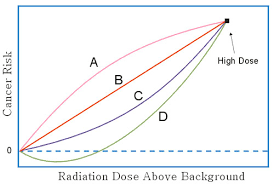Up to now, I've avoided talking about hormesis. This is stupid. Hormesis exists and should be discussed. It's a legitimate alternative to SNT unless I can show otherwise. This post focuses on the gap between claiming hormesis exists and defining a replacement for LNT. A follow on post will explain how someone like myself, who accepts that hormesis is real, can at the same time believe that hormesis is a non-factor in a nuclear power plant release.
Figure 1. The Dumbest Graph of all time. Hormetians argue for Curve D.
Hormesis holds that radiation in the right amount can be beneficial. This is almost certainly true. Experiments in which organisms have been placed in artificially low radiation environments such as lead lined boxes deep within mines, almost invariably show adverse health impacts. The clearest evidence comes from laboratory experiments, usually with mice. The mice are hit with a large challenge dose. When the challenge dose is preceded by a much smaller priming dose, the adverse impact of the challenge dose is reduced, sometimes sharply. This phenomenon has been observed by a half-dozen different labs in scores of experiments.\cite{fornalski-2021} It even has a name. It's called the Yonezawa effect.
But how do we translate these observations into radiation protection policy, especially for nuclear plant releases? Almost all hormetians focus on the Dumbest Graph, Figure 1. They argue for Curve D, which dips below the background cancer incidence for a portion of the dose range. They rarely take it much further. Often they don't even bother putting numbers on the cross-over points. The all important time dimension is not even mentioned. You cannot replace LNT with qualitative, static, hand waving.
Any replacement for LNT must meet the show-me-the-program criterion. The model must come with code that converts an individual's dose rate profile to the corresponding change in cancer incidence. We need this both to write reasonable regulation and to design a radiation exposure compensation program. As far as I know, no hormetian has stepped forth with such a model. So I decided to do one myself.
First thing I had to decide on is a repair period. Any semi-realistic harm model must recognize, not only our ability to repair radiation damage, but also the fact that repair takes time. A repair period of a day seemed like a reasonable compromise and allows us to make direct comparisons with SNT.
Since the RERF atom bomb survivor database is the obligatory Gold Standard for acute dose data, I had little choice but to fit my hormetian model to this data. I needed a curve that dips below the zero point, so I could not use a logistic. I decided rather arbitrarily to go with a cubic spline. Figure 2 compares my eyeball spline fit with LNT and SNT. One can make a strong argument that the spline fit is at least as good if not better than the other two. But no reasonably smooth curve can produce a good fit to the roller coaster RERF data. My fit is beneficial up to about 30 mSv/d.
In any real world nuclear plant release, the daily dose to the public will always be below 10 mSv, and almost always below 1 mSv. So the harm is always negative. The release results in beneficial day after beneficial day. The plant can sell tickets to visit the release. The next step will be to ensure the plant has a release, say, once a month. Then we can accept reservations.
But we don't see a significant reduction in cancer incidence in Karunagappallians that experience 0.2 mSv/d every day in their life. We did not detect a reduction in cancer in the radium dial painters who received between 1 and 20 mSv/d for 10 or more years. We have never detected a significant reduction in cancer after a release. I don't believe my model.
The alternative is a repair period long enough to get the repair period dose above 30 mSv. In most releases for most people, we are talking cell repair periods of a year or more. This is preposterously inconsistent with everything we know about DNA repair.
Perhaps a more accomplished hormetian has some other solution. All I ask is that it be computable. If we are going to replace LNT, we must be able to convert a plume and a population distribution into the corresponding harm/benefit. Don't lecture me on hormesis. Show me your computer program.






"Experiments in which organisms have been placed in artificially low radiation environments such as lead lined boxes deep within mines, almost invariably show adverse health impacts."
Hmmm, this would ideally have a control group of animals placed in lead lined boxes deep within mines *BUT* exposed to radiation.
I don't see much benefit to including hormesis in any compensation scheme. Yes, I believe it is real, but I'm not about to add radon to my basement, and I think most people would feel the same. The reason I favor the radon graph over all the other data I've seen is that a scatterplot is so clear, there just can't be any valid argument that there was some "fudge factor" applied. Yes, that is what the "radon experts" are saying. That is their story, and they are sticking to it, even when you give them a link to the original data.
https://citizendium.org/wiki/Fear_of_radiation/Debate_Guide
My two best links for the anti-LNT view are:
https://www.x-lnt.org/evidence-for-radiation-hormesis
https://hps.org/hpspublications/historylnt/episodeguide.html